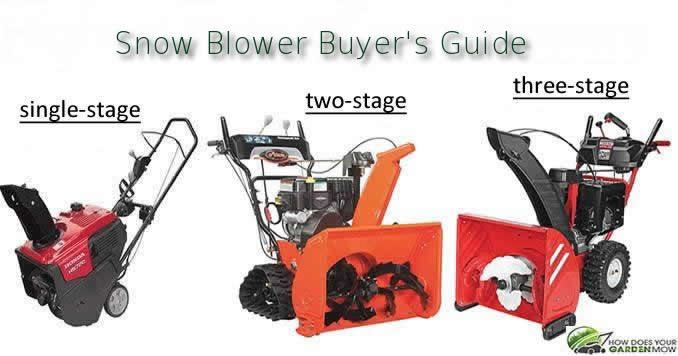As I write this post the sun is splitting the heavens and warm sunshine is streaming through my open window. It’s a glorious summer day but as I was clearing out my garage earlier I was reminded that there is a big empty space where my snow blower used to be. My trusty blower’s engine gave up the fight at the end of lasPreview Changes (opens in a new tab)t winter after giving me many good years of service.
As I live in an area that gets heavy snow I know that I will need a replacement for winter. But why am I so concerned about it now?
Table of Contents
An Extensive Snow Blower Buying Guide
It’s most likely you will be reading this either in the winter or as winter approaches but believe it or not buying a snow blower in the summer is a great money-saving decision to make (more on that later).
Buying a snow blower can be a daunting task.
When faced with so many different sizes, different functions and different engines, not to mention the gas-powered versus electric-powered argument, any normal person will feel that making a buying decision is difficult.
Then, when you are asked to consider single-stage versus two-stage versus three-stage the entire process of buying a snow blower can become downright overwhelming.
So here I cover each of these issues in detail and what they mean to you so you can find the right snow blower to suit your needs.
The 3 Types of Snow Blower
Although snow blowers come in different sizes, with different power sources and different engines they can be placed into three distinct categories:
Single-stage – used for small residential use.
Two-stage – ideal for heavy snow and larger areas. They complete jobs faster than single-stage blowers.
Three-stage – perfect for heavy snow, large areas and wet snow. They also complete jobs 50% faster than two-stage machines.
Here is a quick and simple explanation of the differences between these three categories and what those differences mean for you.
Single-stage snow blowers are best for small residential jobs
A single-stage snow blower is usually more than enough for most small residential areas.
 Single-stage snow blowers have a single auger which runs at high speed to scrape snow from the ground.
Single-stage snow blowers have a single auger which runs at high speed to scrape snow from the ground.
The snow is then propelled up a chute and discharged several feet away in whatever direction the chute is facing.
Most chutes are easily swiveled to point in different directions.
All entry-level snow blowers are single-stage.
These machines are specifically designed to be compact and budget-friendly. Therefore they can usually only handle average snow clearing jobs.
As a rule-of-thumb single-stage snow blowers can usually clear snow with a depth of up to 6″.
Good single-stage blowers can break up compacted snow though if it is deep or very compacted you may need to manually break it up with a shovel first.
The single auger has a rubber leading edge which can help to move the blower in a forward direction as it scoops the snow from the ground.
However, this only gives a slight amount of help pushing the machine.
Therefore single-stage snow blowers are not a great choice for anyone who has to deal with steep driveways or inclines.
They are best suited for tackling small residential areas with light to medium snow that lies no deeper than 6″ on even ground.
Check single-stage snow blowers at Home Depot
Two stage snow blowers are best for more challenging jobs
A two-stage snow blower is the next generation machine up from a single-stage.
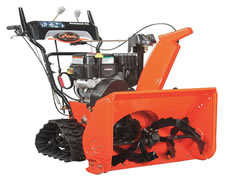 These machines are much more powerful that a single-stage blower and offer a more user-friendly operational experience.
These machines are much more powerful that a single-stage blower and offer a more user-friendly operational experience.
Unlike the single-stage machines a two-stage snow blower uses a cork-screw type of auger that turns slowly.
The auger sends the gathered snow to the center of the machine’s housing before it is propelled at high speed up and out of the chute.
Two-stage snow blowers can usually handle greater depth of snow than single-stage machines and can handle compacted snow much more effectively.
On average a two-stage machine can work with approximately 12″ of snow depth.
Two-stage machines are also usually much wider than single-stage machines as well.
They are also self-propelled and most come with multiple forward speeds.
If you have to deal with large driveways or clear multiple areas and/or you have to deal with steep inclines then a two-stage machine is definitely a better choice than an entry-level single-stage one.
Check two-stage snow blowers at Home Depot
Three stage snow blowers are needed for heavy wet snow & most commercial jobs
Three-stage snow blowers are the newest generation of machine. These are the types of machines you will usually see commercial users operating.
A three-stage snow blower also uses a slow turning auger (though some machines are now using next generation accelerators).
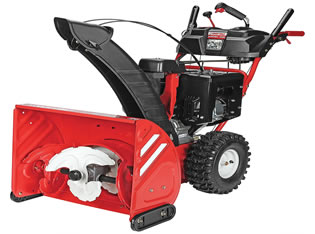 The auger gathers up the snow and like its two-stage counterpart sends it to the center housing before it is propelled up the chute.
The auger gathers up the snow and like its two-stage counterpart sends it to the center housing before it is propelled up the chute.
However, in a three-stage machine this whole process happens much faster.
This makes a three-stage snow blower much quicker at completing a clearing task than either of the other stage blowers.
In fact, on average a three-stage snow blower can remove even the heaviest of snow approximately 50% faster than a two-stage machine in the same size category.
Three-stage snow blowers are designed to easily handle heavy snowfall with depths up to 18″.
They can can easily handle very compacted snow and are the only type of snow blower that is designed to handle wet snow.
Check three-stage snow blowers at Home Depot
Usually the highest rated snow blowers are based on which stage they belong to but there are many other things to factor into your decision.
Let’s take a look at them now.
Types of Power Available On Snow Blowers
Now that you understand the differences between the the stages of snow blowers it’s time to take a look at the power sources available on these machines.
Electric snow blowers have come a long way
Electric power has come a long way and electric snow blowers can rival even the biggest gas-powered models.
As consumers become more aware of the impact they have on the planet most of us are keen to lower our own carbon-footprint.
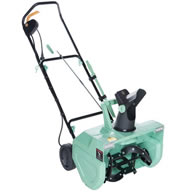 For this reason there has been an explosion in electrical powered garden equipment from electric lawn mowers to electric chainsaws and electric smokers.
For this reason there has been an explosion in electrical powered garden equipment from electric lawn mowers to electric chainsaws and electric smokers.
So, it should come as no surprise that there are also environmentally-friendly snow blowers that are powered by electric engines.
If you are very “green” and are considering an electrically-powered snow blower there are a few things you should consider though.
Firstly, be aware that an electrical snow blower is not the best choice for some users regardless of how much they want to reduce their carbon-footprint.
All electrically-powered snow blowers are single-stage as two-stage and three-stage machines require a more powerful engine.
As I already stated earlier single-stage machines are really only good for small residential jobs.
Therefore if you have large areas to clear a single-stage electric snow blower will not suit you.
The same is true of you are trying to clear a steep area or are tackling heavy snow, compacted snow or wet snow; electric snow blowers are simply not powerful enough to deal with any of those situations.
If an electrical unit will suite your needs then you have a choice between two types.
Cordless electric snow blowers offer convenience but at a price
Cordless electrically-powered snow blowers have a limited time-usage as they usually only give you between 25 minutes to 50 minutes of continual use with a 70 minute to 2 hour charging time depending on the make and model.
For small residential areas this is fine but if you have a larger area, or multiple areas, to clear then a cordless electrical snow blower is just not going to cut it.
Corded snow blowers offer unlimited time usage but are less convenient and space-restrictive
Obviously using a corded electrically-powered snow blower means you don’t have the time limitations associated with cordless machines but you do still have the power limitations.
To get any type of reach with this type of machine you will also need to buy an extension (however they are reasonably cheap and can be sourced from a local store or Home Depot).
Gas-powered snow blowers are the most powerful
 Not all single-stage snow blowers are electric. You can get gas-powered machines and they offer more power than their electrical brothers.
Not all single-stage snow blowers are electric. You can get gas-powered machines and they offer more power than their electrical brothers.
All two-stage and three-stage snow blowers are gas-powered because a gas engine supplies more power than an electric one and these machines are power hungry.
Larger machines with a wider clearing area, that are designed to clear more snow and to also self-propel the machine, require the type of power that can only be supplied by a gas engine.
Two-stage and three-stage snow blowers are always gas-powered.
The wider two-stage snow blowers require a powerful engine to shift all that extra snow so an electrically-powered engine could just not handle this type of usage.
Likewise, in most cases three-stage snow blowers require more power than an electric engine can supply because they are designed to handle very heavy snow fall. And they are also designed to shift heavy wet snow (which requires a lot of power).
Other Considerations When Buying A Snow Blower
Working a snow blower is pretty simple but there are a few things about its operation you should consider before choosing you machine.
Will a simple push model do or do you need power steering & self-propulsion
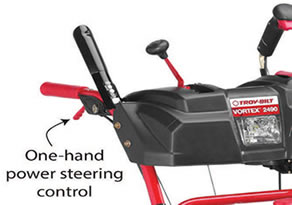 Single-stage machines are powdered by your own energy and effort.
Single-stage machines are powdered by your own energy and effort.
Two-stage snow blowers and three-stage snow blowers are heavy so pushing them is not really an option.
Although most of them are self-propelled, thus removing the difficulty of pushing them, turning them when you reach the end of your path can be difficult if they don’t have assisted steering mechanisms.
The addition of power steering on a snow blower allows for much easier turning and all-round general maneuvering.
Most of the latest snow blower two-stage and three-stage models have, what is called, “one handed power steering”.
This control system allows the user to turn the machine 180° with only one hand while the other remains free to work the controls.
One-hand steering is definitely a feature you will want on your snow blower if you opt for a two-stage or three-stage machine.
Be sure to take a closer look at the snow blower’s chute
When it comes to powered garden equipment we have been conditioned to believe that metal, especially stamped steel, is a better construction material than plastic and for the most part this is true.
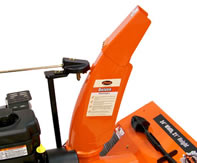 However, when it comes to snow blowers, that are obviously coming into contact with rust-forming material in the form of frozen water, metal is not an ideal material to use.
However, when it comes to snow blowers, that are obviously coming into contact with rust-forming material in the form of frozen water, metal is not an ideal material to use.
Plastic chutes will last much longer than metal chutes simply because they won’t rust.
Additionally modern plastic chutes have been designed to be somewhat flexible so they can be more resistant to the expansion and contraction that comes with cold and changing weather.
As metal chutes rust they also tend to catch snow in them and this clogs up the chute which needs manually cleared.
Obviously this slows down the job and after awhile becomes downright annoying.
If you do buy a snow blower with a metal chute (there are many fantastic machines that still use them) be sure to dry the chute as best you can after use to minimize the risk of rust developing.
Good chute rotation and adequate chute pitch controls will speed up the job
When clearing an area of snow it is necessary to have the ability to change the direction of the snow that is being blown from the chute.
Not only is this important when you turn around after reaching the end of your path but it is often advantageous to change direction even before you reach the end of a path.
Most chute rotation mechanisms on single-stage snow blowers use a crank to change the direction of the chute.
This means you have to stop operating the machine and physically turn the crank.
 In addition these type of mechanisms also mean you have to stop and manually adjust the chute pitch if you need to alter the throwing range.
In addition these type of mechanisms also mean you have to stop and manually adjust the chute pitch if you need to alter the throwing range.
On the more expensive two-stage and three-stage models this is not a problem.
These machines are designed with electronically operated chute rotation mechanisms.
Many now come with joystick controls that allow the user to change direction and pitch directly from the operator’s control panel.
Along with the one-hand operation, via the power steering mechanism, this means a much more user-friendly experience for the operator.
It also means a much faster completion time of a snow-clearing job.
Extras You May Want Included In Your Snow Bower Purchase
Once you have considered the obvious factors for buying a snow blower there are a few extras that you should also consider.
These factors are purely optional but could prove to be important for some users.
Headlights can make snow clearing a lot easier in low light
Anyone who has regularly cleared snow knows that sometimes you need something to light your way.
Because you use a snow blower in the winter you often find its dark before you leave for work and by the time you return home from work its dark again.
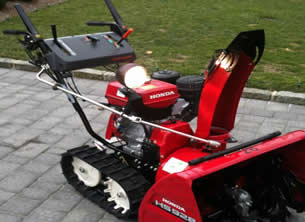 So, whether you clear snow in the morning or the evening, you can be pretty sure you will be doing it in the dark.
So, whether you clear snow in the morning or the evening, you can be pretty sure you will be doing it in the dark.
A headlight will not only allow you to clear snow regardless of the lack of daylight but it can also help you avoid obstacles in low light.
It is all too easy to miss obstacles in low light which could potentially jam and damage your blower.
Unfortunately, not all snow blowers come with headlights. Single-stage snow blowers will not have any light source at all.
The higher-range two-stage snow blowers and three-stage snow blowers will usually have some type of headlight to help illuminate the area directly in front of the user.
Pneumatic vs airless tires. Know what type of grip you need
Pneumatic tires offer many benefits for traversing difficult terrain and that is why they are so popular on a range of garden equipment from sprayers to pull-behind lawn mower trailers.
However, when it comes to snow blowers they can cause problems.
As these tires are air-filled they often need refilling with air (not such a big deal) and should you get a flat tire they will need repairing (a bit more of a big deal).
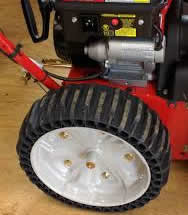 Plus, just like any other engine powdered wheeled-vehicle if the pressure in one tire is different from the pressure in another the entire machine will pull to one side.
Plus, just like any other engine powdered wheeled-vehicle if the pressure in one tire is different from the pressure in another the entire machine will pull to one side.
For this reason most of the more popular snow blowers are now using airless tires.
As they are constructed from a special polymer material which flexes to shed snow they offer as much traction as traditional rubber tires do without any of the potential hassles.
Airless tires as also completely maintenance-free.
An electric start motor is a must
I have included this under “extras” but in truth it should probably be a must-have feature on your snow blower.
No-one wants to tackle a manual start on a cold day especially when they have to tackle shifting snow on their property.
So, make sure your snow blower has an electric start and that it can handle sub-zero temperatures.
Heated handles may sound like a luxury but can be essential with large snow clearing jobs
Heated handles may sound like a complete luxury but if will be spending long periods of time in subzero temperatures clearing snow then having a little extra heat going to your hands can make all the difference.
This feature will only be available on selected two-stage and three-stage machines.
3 Key Considerations Before Making A Purchase
Consider what type of snow you will need to clear
Just as all snow blowers are not created equal not all snow is created equal either.
The type of snow you tend to regularly clear will be a big factor in the type of snow blower that will best suit your needs.
Light to medium snow fall can easily be handled by single-stage snow blower.
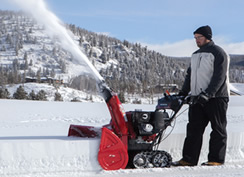 However, if you regularly need to clear heavy and/or compacted snow then you will need a more powerful machine. For such jobs you will need a two-stage snow blower.
However, if you regularly need to clear heavy and/or compacted snow then you will need a more powerful machine. For such jobs you will need a two-stage snow blower.
If you regularly have to clear heavy and/or compacted snow and/or wet snow then you need the next level machine.
Only a three-stage snow blower can adequately handle wet snow.
Also consider the snowfall depth
If you only need to clear snow that is no more than 8″ deep (on even ground) then a single-stage snow blower will be more than capable of handling the job.
If you have deeper snow levels than that then you will need to get a two-stage snow blower.
As a rule-of-thumb the best two-stage snow blowers will be able to handle deeper snow than three-stage snow blowers.
However, they cannot handle wet snow.
So, if you rarely have to deal with wet snow then you would probably be better with a two-stage machine.
The type and size of snow blower you need will depend on the size of the area you need to clear as well
 If you are using your snow blower for residential use then you will most probably be clearing your driveway and sidewalk.
If you are using your snow blower for residential use then you will most probably be clearing your driveway and sidewalk.
Taking into consideration the construction of the area you need to clear is very important when you want to buy a snow blower.
The engine size and stage you choose will depend not only on the type of snow you regularly need to clear but also on the environment you will be clearing.
Is the area even or sloped?
An even area with medium snow fall can be cleared easily with an electrically-powered single-stage snow blower but a driveway with a steep incline and the same type of snow will need gas-powered two-stage machine.
3 Handy Snow Blower Buying Tips
Now you know the differences between the types of snow blowers that are available on the market there are just a few more simple things you should also factor into your decision before you buy.
Size does matter!
Size matters – but not in the way you think!
Bigger does not always mean better.
Consider what width size you really need. You may find that you require a smaller three-stage machine because you have a smaller area to clear but you regularly have to deal with compacted or wet snow.
A two-stage snow blower may be a better machine but if you have a reasonably small area to clear on very even ground then a cheaper single-stage snow blower may be more than enough for your needs.
More expensive doesn’t always mean it’s better
Budget is a big factor when it comes to buying anything.
However, just because you have a budget for a three-stage machine that doesn’t mean you have to get one.
Many two-stage snow blowers are wider than three-stage snow blowers because stage-three machines were designed to tackle more difficult jobs while two-stage machines were initially designed to make the completion of jobs faster.
If you never or rarely have to deal with wet snow but have wide areas to clear then you may be better spending your budget on a high-end two-stage snow blower rather than a three-stage machine.
On the flip side, if you have a smaller area to clear but must regularly battle against very heavily impacted snow and/or wet snow then a smaller three-stage machine is always going to be better option than a bigger two-stage machine.
This is true even if the two-stage machine is more expensive and appears to be a better machine!
 Shop out of season for good deals
Shop out of season for good deals
As I mentioned at the start of this post I am writing it on lovely warm summer day. However, I fully intend to go buy a new snow blower after I hit the publish button.
Why?
Because buying out of season has many advantages.
Firstly, we live in a supply and demand society and there isn’t much demand for winter products in the summer.
People usually shop for lawn mowers in the summer not snow blowers.
So due to a lack of demand when you shop out of season you are more likely to find great deals.
Secondly, when you buy before the start of a new season you are more likely to get a great price on stock that manufactures and sellers want to move before the new season models are released.
Let’s face it, it’s the 21st Century and we have pretty much nailed it when it comes to snow blower deign.
Now, I’m certainly not saying that we have reached the pinnacle of technological advancement as far as snow blowers (or anything) goes but I can say with certainty that each year’s new models will usually differ very little from the previous year’s.
So, getting a great deal on a model that is about to be replaced with a newer model makes good sense from a financial point of view.
Hopefully you have found this snow blower buyer’s guide useful and that you have got a least a few good buying tips from it.

